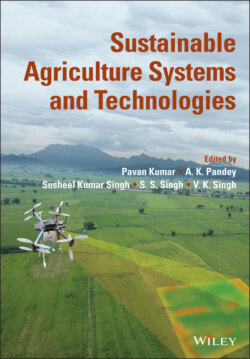Читать книгу Sustainable Agriculture Systems and Technologies - Группа авторов - Страница 55
4.3 Impact on the National Economy
ОглавлениеWe are living in a historical time; the bad thing is that whenever this page of history is opened, it will open with sorrow and suffering. Everyone is talking about the impact of COVID‐19,but only on national or on urban conditions. Unfortunately, not much is being said about the impact of COVID‐19 on the rural sector, even though it is a large part of the economy and plays an important role in the product categories of the country. In the midst of the crisis of COVID‐19, rural India is not becoming an issue of central discussion. Rather it should be in the hour of this crisis that rural economy should be discussed the most. At present, the agricultural sector is one such link which can make the Indian economy run smoothly again in the future. The agricultural sector has recorded a historic decline in the last few years. Annual growth rates of agriculture and allied sectors are 1.5, 5.6, −0.2, 0.6% in 2012–2013, 2013–2014, 2014–2015, 2015–2016, 2016–2017, 2017–2018, and 2018–2019 respectively 6.3, 5.0, and 2.9%. According to the report released by the National Statistics Office in January 2020, the estimate of agricultural growth rate in the year 2019–2020 was only 2.8%. If the crisis continues like this, agricultural development may once again be negative. Despite all the government announcements, due to the ongoing crisis of COVID, the market for agricultural products is ending rapidly. The agricultural sector is also witnessing a supply crisis along with demand. The important fact is that at the present time the economy cannot be divided between the rural and the city.
Figure 4.1 Predictive statistical model for the deflation of COVID‐19 spread in India.
The situation caused by the COVID‐19 crisis and extended lockdown period in India severely affects not only the supply but also the demand for agro‐foods (Ceballos et al. 2020; Mahendra Dev 2020). This directly impacts the economy of 140 million Indian farmers and the share of the GDP associated with agriculture, which has similarly declined. In India, the agricultural yields from local farms for Rabi crops, cereals get stored in cold storages and/or are directly supplied to the Indian market. Food touch prices highly o urban market when mostly cereal production cannot get into market and this situation creates very difficult for both poor people as well as for local farmers (Kumar et al. 2020). To mitigate the immediate challenges related to lockdown, the Government of India (GoI) has provided economic aid or relief packages aimed at many different sectors. The economic aid in general has been critically needed but has also inversely impacted the national GDP (see Figure 4.2).
As shown in Figure 4.2, the national GDP was in March 2020 expected to be down about 0.9 trillion USD in value from FY2020‐Q1 (March 2020) to FYP2020‐Q3 (September 2020). A fair part of this drop is expected to be related to the agricultural sector. For comparison, a novel five‐year scheme worth INR 15 000 crores introduced by the GoI aims to strengthen the state and national level systems in order to combat the health impacts of COVID‐19 (Mohan et al. 2020). This fund was further circulated to intensive care units, supply of oxygen cylinders in medical centers, distribution of mask, sanitizer, oxygen generating plants, and many more. State government of India has planned for health system preparedness package into three phases from 2020 to 2024. The growth rate for FY2021 was initially rated by World Band and other rating agencies with the lowest figures in the last three decades since India's economic liberalization in the 1990s began. The economic packages announced by the GoI in the middle of May 2020 did not help and the country's GDP estimates were downgraded even more to negative figures, signaling a deep recession. Consequently, India was expected to lose over ₹32 000 crores (US$4.5 billion) every day during the first 21 days of complete lockdown declared following the COVID‐19 outbreak (The Hindu Business Line 2020). It has been also estimated that lockdown may affect around 53% of enterprises across the country (The Indian Express 2020) severing almost all economic activity (Kumar et al. 2020). However, the GoI initiated several remedial measures beginning with food security and allocating extra funds for healthcare and states, sector related incentives and tax payment deadline extensions. In the very beginning, on 26 March 2020 itself, a number of economic relief measures for the poor were announced totaling over ₹170 000 crore. Reserve Bank of India also announced to make available ₹374 000 crore to the country's financial bounty. Global financial institutions like the World Bank and Asian Development Bank also supported India to tackle the coronavirus pandemic. Moving further, the Prime Minister announced an overall economic package worth ₹20 lakh crore (US$280 billion) constituting the 10% of India's GDP on 12 May 2020 which was further unfolded by the Indian Finance Minister in the next five days. As a final and booster dose to Indian economy, on 12 October 2020, the finance minister announced an economic stimulus package worth ₹46 675 crore which is 0.2% of the GDP.
Figure 4.2 Recent and expected developments in the GDP of India since the fourth quarter (Q4) of the fiscal year 2018 (FY2018). The numbers shown are from the Reserve Bank of India (RBI), accessed 16 May 2020.
